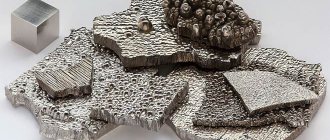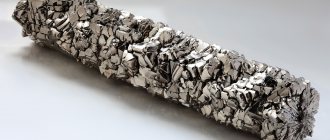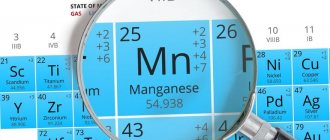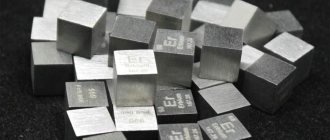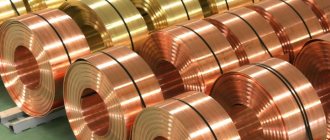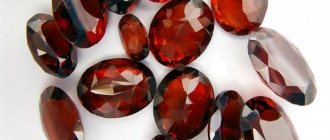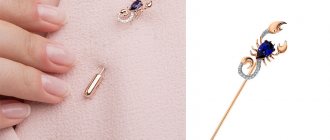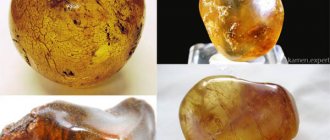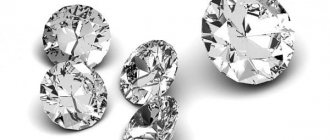Story
The history of niobium is connected with its eternal companion - tantalum.
Niobium crystals
The new element was discovered by C. Hatchet while examining a mineral from Colombia. Therefore, the found element was called columbium. A year later, tantalum was discovered, but it was mistakenly considered “Columbium.” The error was found and corrected 40 years later. Columbia was named niobium, and its companion tantalum.
Metals: general characteristics
All metals share common chemical and physical properties, by which they are easily distinguished from non-metallic substances. For example, the structure of the crystal lattice allows them to be:
- conductors of electric current;
- good heat conductors;
- malleable and ductile;
- durable and shiny.
Of course, there are differences among them. Some metals shine with a silvery color, others with a more matte white, and still others with a generally red and yellow color. There are also differences in thermal and electrical conductivity. However, these parameters are still common to all metals, while non-metals have more differences than similarities.
By chemical nature, all metals are reducing agents. Depending on the reaction conditions and specific substances, they can also act as oxidizing agents, but rarely. Capable of forming numerous substances. Chemical compounds of metals are found in nature in huge quantities in ores or minerals, minerals and other rocks. The oxidation state of metals is always positive and can be constant (aluminum, sodium, calcium) or variable (chromium, iron, copper, manganese).
Many of them are widely used as building materials and are used in a wide variety of branches of science and technology.
Properties
The element belongs to the refractory metals, in the periodic table it has number 41. The Latin name is Niobium, in chemical formulas it is designated by the symbol Nb.
Some characteristics:
- color silver-gray;
- crystal structure of the lattice is body-centered, cubic;
- consists of the stable isotope Nb93;
- has high cold resistance.
- has paramagnetic properties.
| Properties of the atom | |
| Name, symbol, number | Niobium (Nb), 41 |
| Atomic mass (molar mass) | 92.90638(2)[1] a. e.m. (g/mol) |
| Electronic configuration | [Kr] 4d4 5s1 |
| Atomic radius | 146 pm |
| Chemical properties | |
| Covalent radius | 164 pm |
| Ion radius | (+5e)69 pm |
| Electronegativity | 1.6 (Pauling scale) |
| Electrode potential | |
| Oxidation states | 5, 4, 3, 2, 1 |
| Ionization energy (first electron) | 663.6(6.88) kJ/mol (eV) |
| Thermodynamic properties of a simple substance | |
| Density (at normal conditions) | 8.57 g/cm³ |
| Melting temperature | 2741 K (2468 °C, 4474 °F) |
| Boiling temperature | 5015 K (4742 °C, 8567 °F) |
| Ud. heat of fusion | 26.8 kJ/mol |
| Ud. heat of vaporization | 680 kJ/mol |
| Molar heat capacity | 24.44[2] J/(K mol) |
| Molar volume | 10.8 cm³/mol |
| Crystal lattice of a simple substance | |
| Lattice structure | cubic body-centered |
| Lattice parameters | 3.301 Å |
| Debye temperature | 275 K |
| Other characteristics | |
| Thermal conductivity | (300 K) 53.7 W/(mK) |
| CAS number | 7440-03-1 |
Chemical properties:
- It does not react with most acids (except for hydrofluoric acid and its mixture with nitric acid).
- Stable in melts of many metals.
- Reacts with concentrated caustic alkalis.
- With increasing temperature, the oxidation of the metal increases rapidly.
- At 9°K it becomes a superconductor.
We recommend: GOLD - a gift or curse to humanity
Informative: niobium and tantalum are twin brothers. They are always nearby in ores, and it is not easy to separate them. The easiest way to distinguish identical pieces of metal is by weight - the density of niobium is almost 2 times less than that of tantalum. In addition, tantalum is much more expensive than our hero.
Being in nature
Clarke niobium - 18 g/t. Niobium content increases from ultramafic (0.2 g/t Nb) to felsic rocks (24 g/t Nb). Niobium is always accompanied by tantalum. The similar chemical properties of niobium and tantalum determine their joint occurrence in the same minerals and participation in common geological processes. Niobium can replace titanium in a number of titanium-containing minerals (sphene, orthite, perovskite, biotite). The form of occurrence of niobium in nature can be different: dispersed (in rock-forming and accessory minerals of igneous rocks) and mineral. In total, more than one hundred minerals containing niobium are known. Of these, only a few are of industrial importance: columbite-tantalite (Fe, Mn)(Nb, Ta)2O6, pyrochlore (Na, Ca, TR, U)2(Nb, Ta, Ti)2O6(OH, F) (Nb2O5 0 - 63%), loparite (Na, Ca, Ce)(Ti, Nb)O3 ((Nb, Ta)2O5 8 - 10%), sometimes euxenite, torolite, ilmenorutile are used, as well as minerals containing niobium as impurities ( ilmenite, cassiterite, wolframite). In alkaline - ultramafic rocks, niobium is dispersed in perovskite-type minerals and in eudialyte. In exogenous processes, niobium and tantalum minerals, being stable, can accumulate in deluvial-alluvial placers (columbite placers), sometimes in bauxites of the weathering crust. The concentration of niobium in sea water is 1⋅10−5 mg/l.
Place of Birth
Niobium deposits are located in the USA, Japan, Russia (Kola Peninsula), Brazil, and Canada.
Niobium production by country (tonnes) (USGS estimate) Country200020012002200320042005200620072008200920102011
| Australia | 160 | 230 | 290 | 230 | 200 | 200 | 200 | ? | ? | ? | ? | ? |
| Brazil | 30 000 | 22 000 | 26 000 | 29 000 | 29 900 | 35 000 | 40 000 | 57 300 | 58 000 | 58 000 | 58 000 | 58 000 |
| Canada | 2,290 | 3,200 | 3,410 | 3,280 | 3,400 | 3,310 | 4,167 | 3020 | 4380 | 4330 | 4420 | 4400 |
| Democratic Republic of the Congo | ? | 50 | 50 | 13 | 52 | 25 | ? | ? | ? | ? | ? | ? |
| Mozambique | ? | ? | 5 | 34 | 130 | 34 | 29 | ? | ? | ? | ? | ? |
| Nigeria | 35 | 30 | 30 | 190 | 170 | 40 | 35 | ? | ? | ? | ? | ? |
| Rwanda | 28 | 120 | 76 | 22 | 63 | 63 | 80 | ? | ? | ? | ? | ? |
| Total in the world | 32 600 | 25 600 | 29 900 | 32 800 | 34 000 | 38 700 | 44 500 | 60 400 | 62 900 | 62 900 | 62 900 | 63 000 |
Where to look
The occurrence of niobium in nature almost always accompanies minerals containing tantalum.
Ore deposits have:
- Australia;
- Brazil;
- Russia;
- USA;
- Canada.
We are proud: Russia has a quarter of the world's ore reserves.
About 100 niobium-containing minerals are known; they almost always contain tantalum.
Historical reference
Opened in 1801 chemist C. Hatchett and named “Columbium” (based on the origin of the mineral from which Hatchett isolated it in the form of an oxide). For several decades, columbium and tantalum, which is similar in properties, were considered one and the same element. The individuality of Columbia was proven in 1844, when it was “discovered” for the second time. chemist G. Rose and named “N.” (named after Niobe, the daughter of Tantalus in ancient Greek mythology; the name emphasizes the similarity of the properties of N. and tantalum). In 1845, Rose established that N. is identical to Columbia. In a number of countries (USA, England) the name has been used for more than 100 years. "Columbium" (Columbium, Cb). Name "N." approved by IUPAC in 1950.
Niobium production
Industrial methods for producing pure metal:
- aluminothermy;
- carbothermy;
- sodiumthermia.
Production includes pre-concentration of the ore and several process steps:
- The concentrate is fused with caustic soda or soda; the alloy is leached.
- Nb and Ta precipitate into an insoluble precipitate, which are separated.
- Oxides of rare metals are reduced separately.
Powdered metal is obtained by electron beam, arc or vacuum melting.
Chemical compounds of metals
Among these, several main classes of substances should be mentioned, which are products of the interaction of metals with other elements and substances.
- Oxides, hydrides, nitrides, silicides, phosphides, ozonides, carbides, sulfides and others are binary compounds with non-metals, most often belonging to the class of salts (except oxides).
- Hydroxides – general formula Me+x(OH)x.
- Salt. Metal compounds with acidic residues. May be different:
- average;
- sour;
- double;
- basic;
- complex.
4. Compounds of metals with organic substances - organometallic structures.
5. Compounds of metals with each other - alloys, which are obtained in different ways.
Alloys
In alloys the following is used as a master alloy:
- tungsten;
- vanadium;
- titanium;
- molybdenum;
- zircon.
To increase heat resistance, tungsten, zirconium, and molybdenum are introduced into niobium compounds.
Alloy grades:
- VN2;
- VN2L;
- SV-65;
- NBC;
- NbtsU;
- Nb5V2MC.
Informative: stainless steel parts work in strong acid environments for 2-3 months; parts made of niobium and its alloys last 2-3 years in these environments.
Notes
- Editorial team: Knunyants I. L. (chief editor).
Chemical encyclopedia: in 5 volumes - Moscow: Soviet Encyclopedia, 1992. - T. 3. - P. 249. - 639 p. — 50,000 copies. — ISBN 5—85270—039—8. - Venetsky S.I.
Forty-one // Stories about metals. - Moscow: Metallurgy, 1979. - 240 p. — 60,000 copies. - JP Riley and Skirrow G. Chemical Oceanography V. I, 1965
- Larry D. Cunningham.
. Minerals.usgs.gov (April 5, 2012). Access date: August 17, 2012. - (unavailable link). Access date: February 7, 2009.
- (unavailable link). Euro-Coins.News. Access date: March 12, 2012.
- (unavailable link). World of coins. Access date: March 19, 2012.
- Titanium is also used for this in the same quantities.
- (unavailable link). Access date: December 5, 2007.
- (unavailable link). Access date: December 5, 2007.
What is made from niobium
Products made from niobium and its alloys are consumed by:
- electronics industry;
- aviation;
- nuclear physics;
- metallurgy.
The use of superconductivity in tomography and MRI studies in medicine helps doctors in the early detection of diseases.
Cooling of quantum computers, cables for the Large Hadron Collider, refractories, fuel rods for nuclear devices - our hero and his alloys work everywhere.
We recommend: COBALT - a generous gift from mountain spirits
The metal can be used in the jewelry industry. Its oxide films produced by electrolysis come in a variety of vibrant colors; it all depends on the electrolyte and temperature.
Interesting: several countries issue collectible coins with cores anodized with multi-colored niobium alloys.
The alloying properties of the metal give the alloys refractoriness, strength, and corrosion resistance.
Experimental physicists cannot do without niobium compounds (chemical formulas NbN, Nb3Sn, Nb3Ge, NbTi) - they have superconductivity.
Application area
According to the USGS (United States Geological Survey), about 80 percent of Nb is used in the steel industry to create high-strength, low-alloy steels. The properties of niobium make it possible to use it in alloys, which increases mechanical and heat resistance, impact strength and corrosion resistance.
Other uses include pipeline construction, superalloys for heat-resistant equipment, as well as jet engines and jewelry. Niobium, tungsten, molybdenum, tantalum and rhenium are known as the five refractory metals. All of them have very high resistance to heat and wear.
Niobium is used in the steel industry
Industrial use of Nb began in the early 1900s. Niobium's largest market (>80%) is in the high-strength, low-alloy steel industry, where it provides high heat resistance and corrosion resistance for gas pipelines, automotive components, and structural steel.
Nb, like tantalum, allows alternating current to flow in only one direction through the electrolyser. Niobium metal is used in arc welding rods for stabilized grades of stainless steel. Its most interesting applications are in the field of superconductivity. Superconducting magnets are made of Nb-Zr (niobium and zirconium) wire, which maintains superconductivity in strong magnetic fields.
